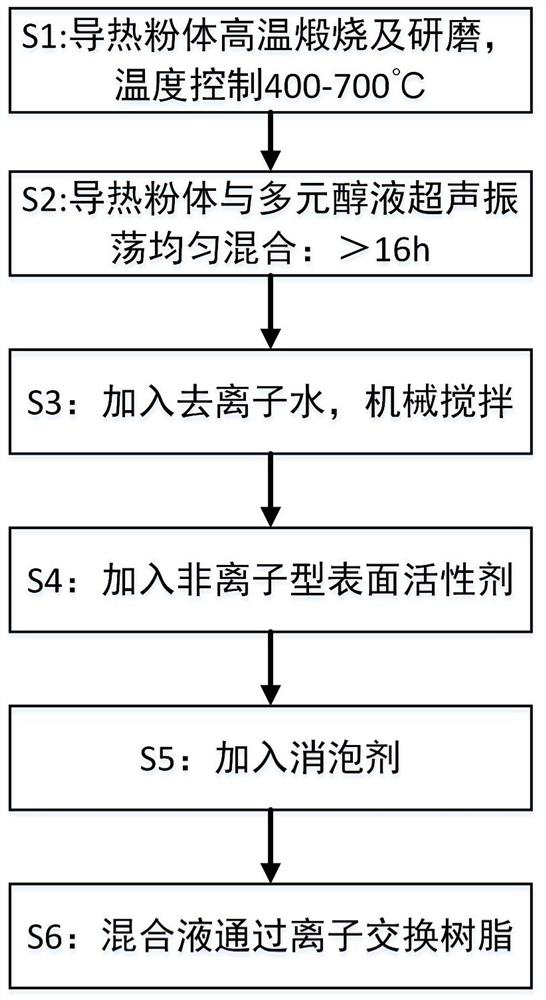Fuel cell cooling liquid and preparation method thereof
A fuel cell and coolant technology, applied in fuel cells, chemical instruments and methods, circuits, etc., can solve the problem of not meeting the high-load heat dissipation requirements of high-power density fuel cells, affecting the performance life of fuel cells, and affecting the overall performance of fuel cells, etc. problems, to achieve the effect of being suitable for mass production and commercial promotion, good insulation, and improved thermophysical properties
- Summary
- Abstract
- Description
- Claims
- Application Information
AI Technical Summary
Problems solved by technology
Method used
Image
Examples
Embodiment 1
[0030] Such as figure 1 Shown, choose TiO 2 Thermally conductive powder, with a particle size range of about 80nm, is calcined at high temperature for 4 hours under oxygen ambient conditions, and the temperature is controlled at 500°C.
[0031] After waiting for the heat-conducting powder to cool down, pour it into an ultra-fine nano-bead mill for forced grinding for 2 hours.
[0032] Weighed by a balance, mixed the heat-conducting powder and the ethylene glycol organic liquid in a mass ratio of 1:8, and ultrasonically oscillated at a frequency of 20 MHz for 16 hours to form a suspension mixture.
[0033] Add deionized water with a conductivity of less than 0.1 μs / cm to the mixture, the mixing mass ratio is 1:1, and mechanically stir for 5 hours.
[0034] A polyethylene glycol-type nonionic surfactant was added to the mixture, and the mass proportion of the surfactant was 0.2%, and mechanically stirred for 6 hours to fully adsorb the surfactant on the surface of the particle...
Embodiment 2
[0039] Select Al 2 o 3 Thermally conductive powder, with a particle size range of about 50nm, is calcined at high temperature for 6 hours under nitrogen ambient conditions, and the temperature is controlled at 600°C.
[0040] After waiting for the heat-conducting powder to cool down, pour it into an ultra-fine nano-bead mill for forced grinding for 3 hours.
[0041] Weigh with a balance, mix the thermally conductive powder and ethylene glycol organic liquid at a mass ratio of 1:12, and ultrasonically vibrate at a frequency of 20 MHz for 16 hours to form a suspension mixture.
[0042]Add deionized water with a conductivity of less than 0.1 μs / cm to the mixture, the mixing mass ratio is 1:1, and mechanically stir for 5 hours.
[0043] Add polyoxyethylene-type nonionic surfactant to the mixed solution, the mass ratio of surfactant is 0.4%, and mechanically stir for 6 hours, so that the surfactant is fully adsorbed on the particle surface.
[0044] Add a polyether-modified poly...
Embodiment 3
[0048] Select ZnO thermally conductive powder with a particle size range of about 30nm, and calcinate at high temperature for 4 hours under oxygen ambient conditions, and the temperature is controlled at 500°C.
[0049] After waiting for the heat-conducting powder to cool down, pour it into an ultra-fine nano-bead mill for forced grinding for 2 hours.
[0050] Weighed by a balance, mixed the heat-conducting powder and the ethylene glycol organic liquid in a mass ratio of 1:10, and ultrasonically oscillated at a frequency of 20 MHz for 16 hours to form a suspension mixture.
[0051] Add deionized water with a conductivity of less than 0.1 μs / cm to the mixture, the mixing mass ratio is 1:1, and mechanically stir for 5 hours.
[0052] Sodium dodecylbenzenesulfonate nonionic surfactant was added to the mixed solution, the surfactant mass ratio was 0.6%, and mechanically stirred for 6 hours, so that the surfactant was fully adsorbed on the particle surface.
[0053] Add a polyethe...
PUM
| Property | Measurement | Unit |
|---|---|---|
| particle size | aaaaa | aaaaa |
| size | aaaaa | aaaaa |
Abstract
Description
Claims
Application Information
 Login to View More
Login to View More - R&D
- Intellectual Property
- Life Sciences
- Materials
- Tech Scout
- Unparalleled Data Quality
- Higher Quality Content
- 60% Fewer Hallucinations
Browse by: Latest US Patents, China's latest patents, Technical Efficacy Thesaurus, Application Domain, Technology Topic, Popular Technical Reports.
© 2025 PatSnap. All rights reserved.Legal|Privacy policy|Modern Slavery Act Transparency Statement|Sitemap|About US| Contact US: help@patsnap.com

